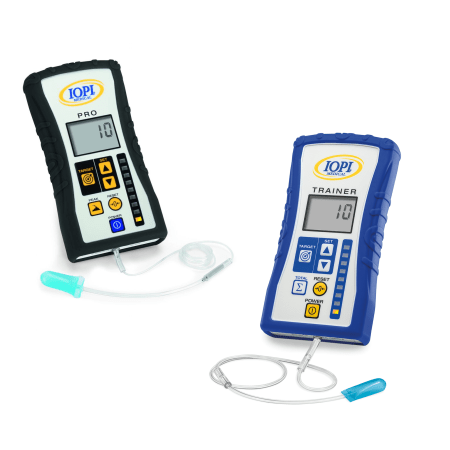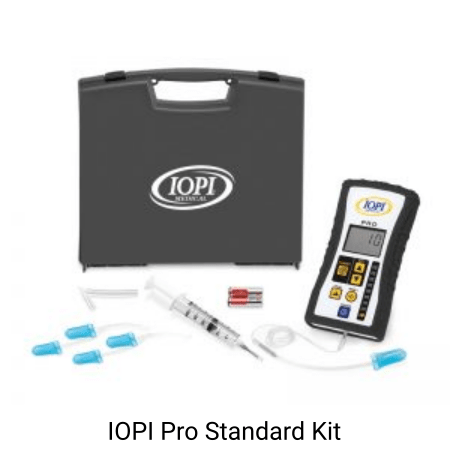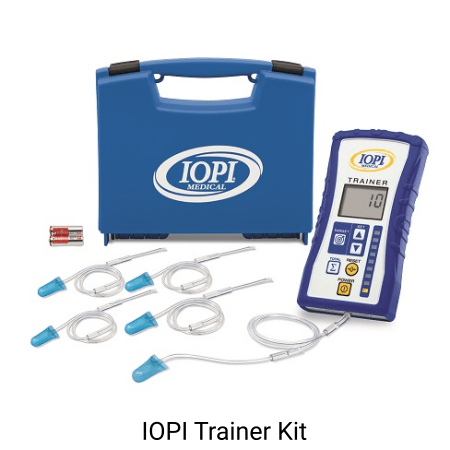IOPI System
Objectively measures tongue and lip strength and endurance.
The IOPI is used in tongue and lip therapy to easily and reliably evaluate the progress of restoring certain functions or recovering from trauma.
It is also used for early diagnosis of several diseases and medical conditions and to start oral motor therapy faster in order to improve speech, swallowing or eating functions.
There are 3 options available:
- IOPI Pro Standard System
- IOPI Pro Deluxe System
- IOPI Trainer System
hidden
Enquire Now
The IOPI measures tongue strength by capturing the maximum compressive force applied to a disposable tongue bulb. The patient presses the tongue bulb against the palate as hard as they can and the IOPI provides the peak pressure reading on an easy-to-read digital display.
The IOPI can be useful in diagnosing and treating:
- Dysphagia
- Stroke
- Traumatic brain injury (TBI)
- Parkinsons
- Head and neck cancer
- The Elderly
It is used by:
- SLPs and SLTs
- Rehabilitation departments
- Hospitals (including VA)
- Head and neck surgery departments
- Occupational therapists
- Otolaryngologists
Options Available
IOPI PRO Standard Kit – Code: 1-3100-SD
- 1 x IOPI Model 3.1
- 1 x Pro Carrying Case
- 5 x Tongue Bulbs
- 1 x Connecting Tube
- 1 x Accuracy Check Syringe
- 1 x User Manual
- 2-year warranty
IOPI PRO Deluxe Kit – Code: 1-3100-1-3100-DL
- 1 x IOPI Model 3.1
- 1 x Pro Carrying Case
- 5 x Tongue Bulbs
- 1 x Connecting Tube
- 1 x Accuracy Check Syringe
- 1 x User Manual
- 2-year warranty
- 1 x IOPI Report Generator
- 1 x spare Connecting Tube
IOPI Trainer System – Code: 1-3200
- 1 x IOPI Model 3.2
- 1 x Trainer Carrying Case
- 5 x Trainer Bulbs
- 1 x User Manual
- 2-year warranty
How does the IOPI measure strength?
The IOPI measures the strength of the tongue by measuring the maximum pressure that an individual can produce in a disposable standard-sized tongue bulb by pressing the bulb against the roof of the mouth with the tongue. The peak pressure achieved is displayed on a large, easy-to-read LCD. The units displayed are kilopascals (kPa), based on the internationally-recognized unit of pressure, the Pascal (Pa).
The IOPI has been validated in many scientific studies, and normal standards exist for tongue elevation strength. Lip compression strength depends on the strength of the circumferential muscle complex that surrounds the mouth. It is the tension in these muscles that allows the lips to be compressed against one another. The bulb, placed between the lips or under the cheek at the corner of the mouth, measures the maximum pressure created when a patient presses their lips together or “purses” as hard as they can.
How does the IOPI measure endurance?
In patients with dysphagia or dysarthria, oral motor fatigability may be of interest. The IOPI can be used to assess tongue fatigability by measuring its endurance, which is inversely proportional to fatigability. Low endurance values are an indicator of a high fatigability.
Endurance is measured with the IOPI by quantifying the length of time that a patient can maintain 50% of his or her Peak pressure. This procedure is conducted by setting the maximum pressure in the Lights Mode to 50% of the patient’s Peak pressure and timing how long the patient can hold the top (green) light on.
How is the IOPI used for exercise therapy?
The IOPI has a vertical row of lights (LEDs) on the front. The higher the pressure, the higher the position of the light that is turned on. Producing a pressure that can turn on the top (green) light can be thought of as “winning”(“I hit the target!”).
The pressure required to illuminate the green light at the top of the IOPI’s light array can be adjusted using the Set Max arrow buttons. The medical professional determines what target value is appropriate for exercise therapy purposes and provides specific instructions to the patient for a particular exercise protocol. A protocol should include the target value to set, the number of times to illuminate the green light and, for each repetition, how long the green light should be illuminated before releasing pressure on the bulb.
The IOPI System
The IOPI System provides everything you need to get started: an IOPI device in a Carrying Case, 1 Connecting Tube, 10 Tongue Bulbs, and a User Manual.
The IOPI Device
The IOPI provides an objective way to measure tongue and lip strength and endurance. The PEAK function allows measurement of Pmax (maximum pressure, in kPa), the LIGHTS function provides biofeedback for exercise and/or endurance measurements, and the TIMER function allows measurement of time (useful for measuring endurance).
IOPI Connecting Tube Connecting Tube
This is a thin 2′ tube that connects the Tongue Bulb to the pressure port on the IOPI device. This tube is considered part of the basic unit and is not replaced with each patient. It is common to store it on top of the IOPI in the Carrying Case so that it does not get lost between uses.
IOPI Tongue Bulb
The tongue bulb has two parts—the bulb and the stem. To measure tongue elevation strength, the blue bulb is placed in the patient’s mouth just behind the alveolar ridge. The SLP is instructed to hold onto the stem of the tongue bulb any time it is in a patient’s mouth.
These Tongue Bulbs are SINGLE PATIENT USE—that means they can be used with the SAME patient repeatedly, but cannot be used with a second patient. To clean the Tongue Bulb for use with the same patient, it can be washed with dish detergent and dried before storage. A small plug is provided to prevent water from getting down the tubing during this process.
IOPI Carrying Case
The Carrying Case was specifically designed to store the IOPI and protect it from damage. The foam insert is custom molded so that the IOPI fits tightly in the foam.












